# Create a SHOTS-only Production
Now that you have designed your workflow in Kitsu and invited more people, it's time to create your Production.
Click on the Create a new production button.

Enter your production name, select only shots as the type, and select the style that best suits your Production.
Then, you must fill in technical information, such as the number of FPS, the Ration, and the Resolution.
All these data will be used when Kitsu re-encodes the video previews uploaded.
Then, you need to define your Production's start and end dates.
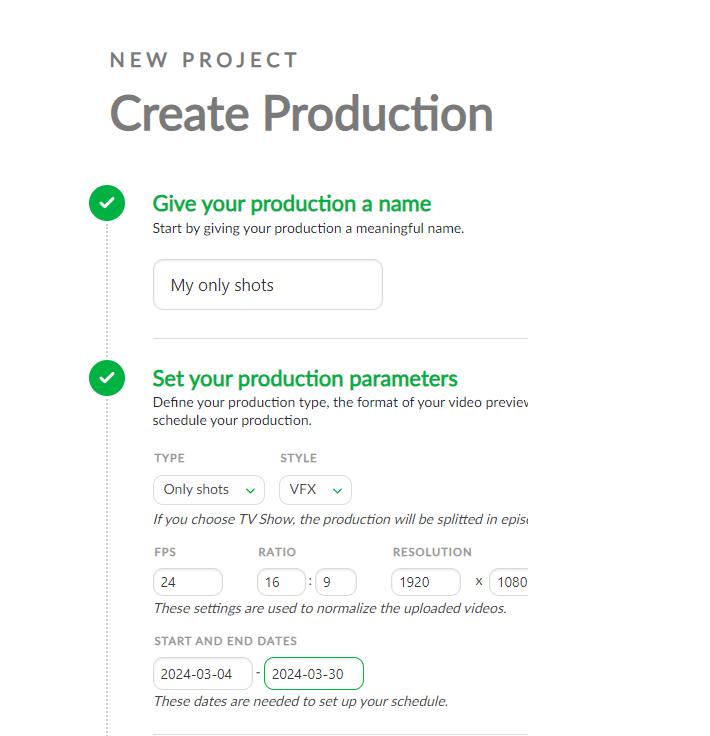
You need to select your shots workflow (Task Type) (3) and your validation process (Task Status) (4),
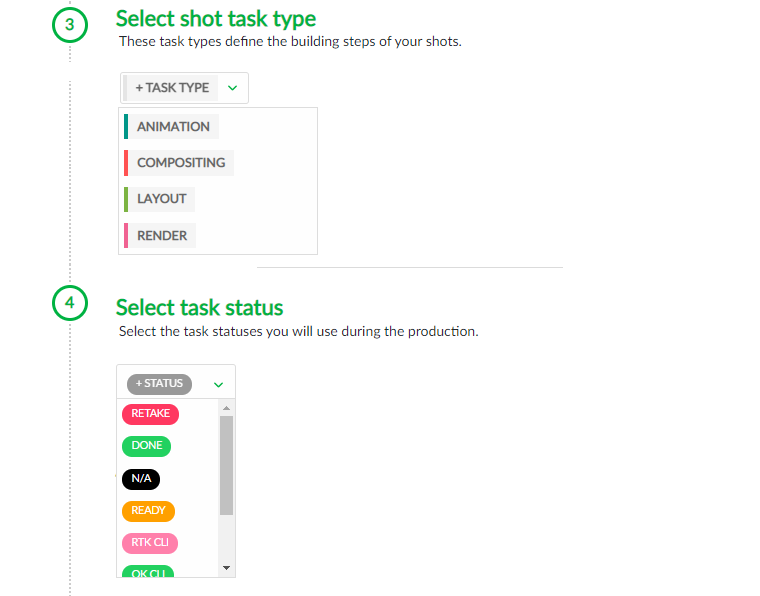
TIP
To create your Production Workflow, you will select Task Types from the Global Library.
If you realize you missed some Task Types, you can create them later.
See the Studio Workflow section.
Then, 5 is the option parts. If you already have a spreadsheet with your shot.
See the import CSV section for more details.
[Import shot](../short-shot/README.md#create-shots-from-an-edl-file
Validate everything with the button.
# Introduction to the Kitsu Global Page
Welcome to Kitsu's global asset page.
Let's take a look around.

On the top part (1), you have the global navigation, which is always visible throughout all the production pages.
From left to right:
# Main Menu
By clicking on the top left button, Kitsu (or your Studio logo), you will open the Main Menu.
On the Main Menu, you will find direct access to your assigned tasks, productions, global and team schedules, the workflow customization page, and the Kitsu settings.
Main Menu Details
WORKSPACE
- My Tasks: your assigned tasks
- My Checks: All the tasks with status Is Feedback Request depending on your department(s)
- My Productions: Get back to the selection on the production page.
STUDIO
- Productions
- People
- Timesheets
- Main Schedule
- Team Schedule
- All tasks
- News Feed
- Entity Search
ADMIN
- Departments
- Task Types
- Asset Types
- Custom Actions
- Automation
- 3D Backgrounds
- Bots
- Settings
- Logs
Permission Visibility
The WORKSPACE section is enabled for all permissions except My Checks, which artists do not see.
Artist (and above) can also see their own Timesheets, and have access to the Entity Search
# Navigation
You will see the navigation dropdown menu on the right of the main menu icon.

You can choose between Production. The name of the actual Production and page are always displayed.
You can use the dropdown menu to navigate from Production to Production (if you have several).
Once you have selected a production, the next dropdown menu will help you navigate through the different pages of this Production.
Navigation details
The first section is about the tracking of your tasks
- Shots
- Sequence
- Edits (If you have created specific tasks)
The second section is more about the side of the Production
- Concepts
- Playlists
- News feed
The third section is about statistics
- Sequence Stats
The fourth section is related to Team Management
- Schedule
- Quotas
- Team
The fifth section is about the settings of your Production
- Settings
TIP
You start with the asset page, but you can change your production homepage to other entities (see setting page)
WARNING
If you realize you need an extra level of navigation, such as Episodes, you need to change your production Type to a TV Show.
If, on the contrary, you realize you need the assets instead of the Only Shots, you need to switch your production type from Only Shots to Short.
# Global Search, News, Notification and Documentation
You have the global search on the right of the navigation dropdown menu. It's a quick access search that will display the four first results. If you need more results and filtering options, see the Entity Search page.
The next icon is a direct link to our news and feedback page.
You can see all the new features with an animated gif and also add suggestions about the next feature you want to see in Kitsu.
Next, the bell icon displays your notifications (assignments, comments, tags). The number of unread notifications will be shown on the bell icon. There are various filters to help you stay on top of updates and revisit important ones when needed. You can easily mark notifications as read or unread or quickly filter by watching/non-watching to focus on what matters most and declutter your feed.
The last icon before your avatar is the documentation button.
, that you are reading right now!
# Personal Settings
You can click on your avatar to open your menu (setting, documentation, etc.).
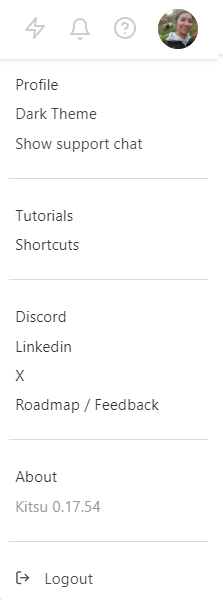 .
.
# The Tasks Spreadsheet
# Entity spreadsheet
The second part of the screen is common to all the entities (asset, shot, sequence, Edit). This is the global tasks spreadsheet.
Here, you see the status, assignation, priority, etc, for each task.
TIP
The first line and column header of the spreadsheet always appear at the top of the page, even if you scroll down.
You can also Stick other columns to keep them visible at all times.
# Filters
The first element on the left is the filter box. You can type anything you want for simple filtering, sequence, asset type, etc.
If you need more advanced filtering, please use the filter builder button.
You can then save all the filters and use them as your pages.
# Simplify the display
On the right part of the screen, there are some buttons (from left to right) to hide or display the assignation, hide or display the extra column, enlarge or reduce the thumbnail,
# Import / Export
batch import thumbnail , and finally import
or export
data.
# Metadata column
Below, you have the name of the column. the (+) next to Name is here to create a new metadata column. Then, you have the name of the task type column.
# Customize the view
On the far right of the screen, next to the scroll bar, is the option to hide and display a text column
.
# Sum-up of your view
The last part (4), at the bottom of the screen, is the sum-up of your displayed page. It means the sum-up will update if you filter the page.
You can see the number of elements (assets or shots), the total number of estimated days, and the total number of days already spent.
# Create a Shot
# Create your first shot
It's time to create shots for your Production.
WARNING
Shots are linked to Sequences in Kitsu. This means you need to first create a sequence and then populate this sequence with shots.
You need to go to the Shots page: you can use the dropdown menu and click on the SHOTS.
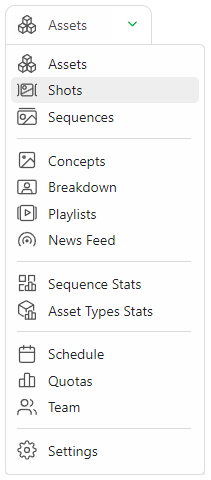
Click on the Add shots button to start with the shot creation.
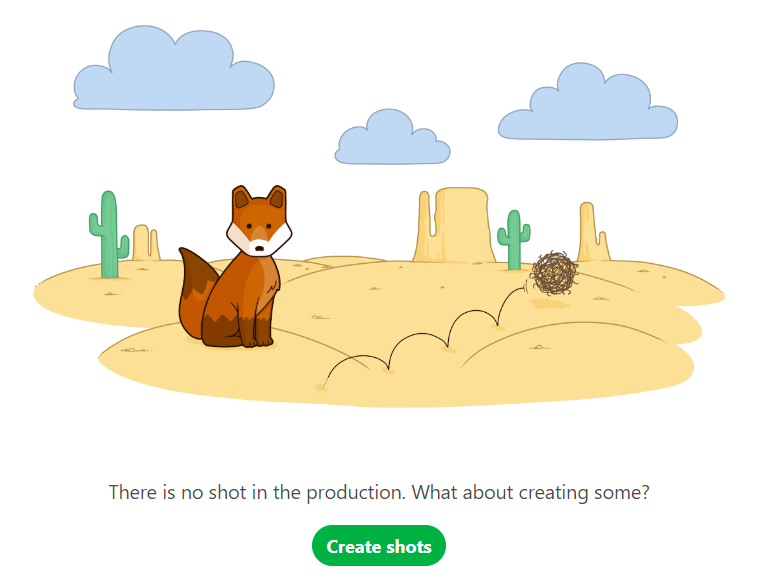
WARNING
When you create a shot, the task workflow you have designed will be applied, and all the tasks will be created at the same time as the shot.
A new pop-up opens for the creation of the shots. You can now create the sequences and the shots.
Enter the first sequence, for instance, sq01, then add.
Now, you can see your sequence has been created. To add shots to this sequence, you need to select it and create your shots.
For example, type sh0010 on the shots column, then again add. You can also define padding for your shots.
TIP
If you want to name your shots ten on ten as SH0010, SH0020, SH0030, etc, set the Shot Padding as 10

You can now see that new shots are listed and linked by their sequence. You have created the first shot of the first sequence.
Now, let's add more shots than just one! As you can see, the box already contains your name code but incremented, so you have to continue to click on add to create more shots.
To add more sequences, go to the left part, type the name of your new sequence, and then click on add. Your second sequence is selected, and you can now add shots.
TIP
If a shot is misplaced on a sequence, you have to edit the shot
, and change the
sequence.
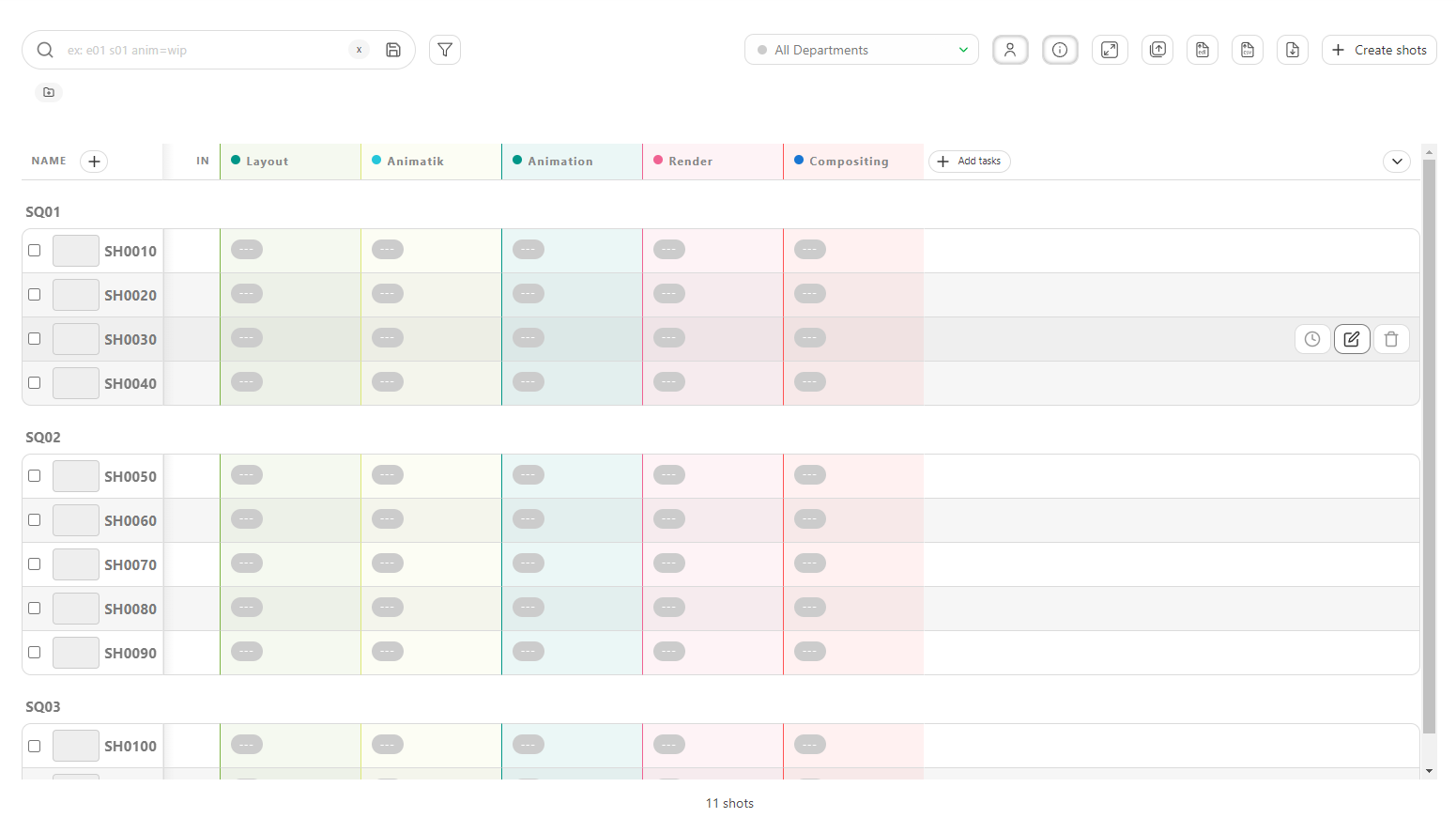

# Create Shots from an EDL File
You may already have your shots list ready in an EDL file. With Kitsu, you can import your EDL file directly to create the sequence, shot, number of frames, Frame in and frame out, and more.
On the Global Shot Page, you will see an Import EDL button.
You can select the naming convention of the video file used during the editing on the pop-up.

It means the video clip on the editing is named as project_sequence_shot.extension.
Here is an example of an EDL for the LGC production.
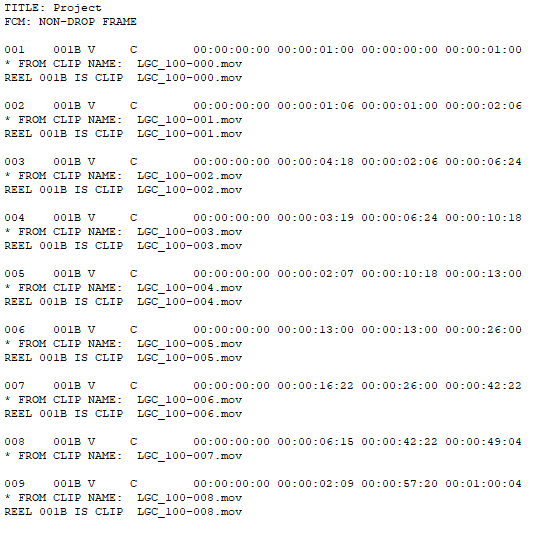
The video files are named LGC_100-000.mov, which means LGC is the production name, 100 is the sequence name, and 000 is the shot name.
You can import the EDL file once you are set with the naming convention.
Then click on Upload EDL
Then Kitsu will create the shots.
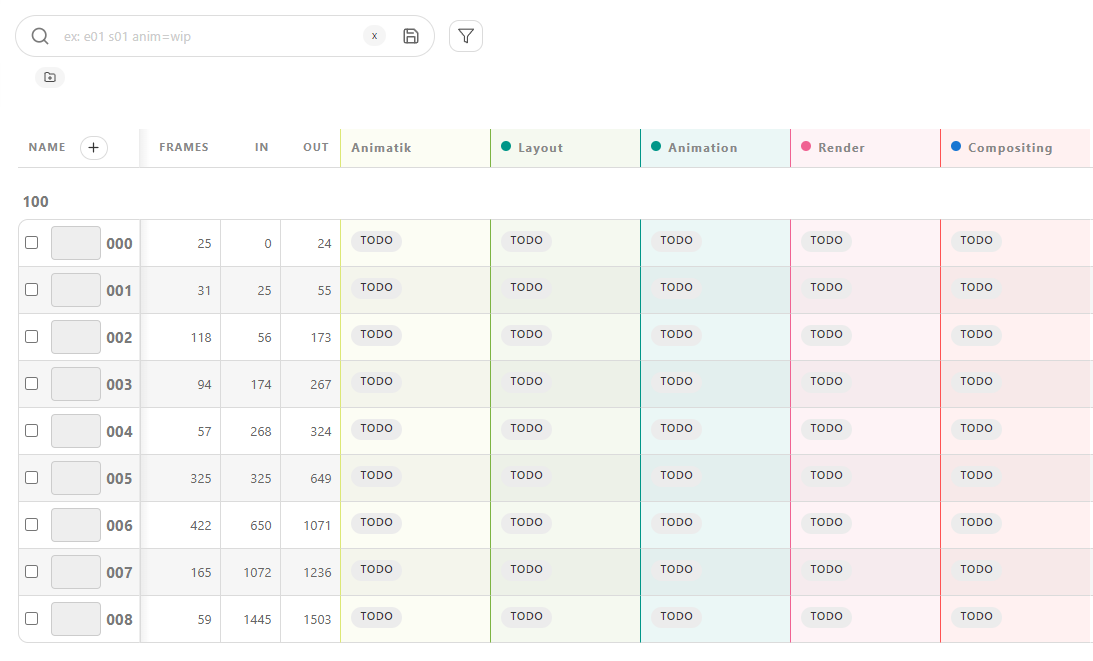 :::
:::
Create Shots from a CSV Spreadsheet File
You may already have your shots list ready in a spreadsheet file.
With Kitsu, you have two ways to import them; the first is to import a .csv file directly, and the second is to copy-paste your data directly into Kitsu.
First, save your spreadsheet as a .csv file.
Then, return to the shot page on Kitsu and click the Import icon.
A pop-up window Import data from a CSV opens. Click on Browse to pick your .csv file.
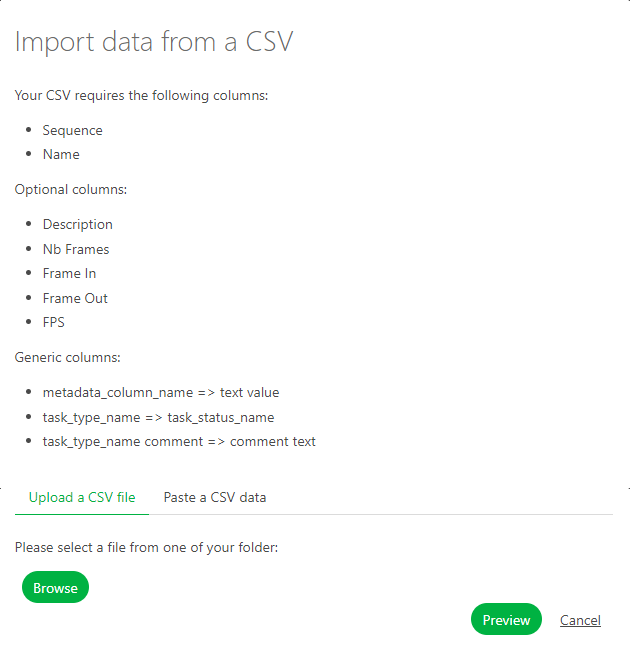
To see the result, click on the Preview button.
You can check and adjust the name of the columns by previewing your data.
NB: the Episode column is only mandatory for a TV Show production.
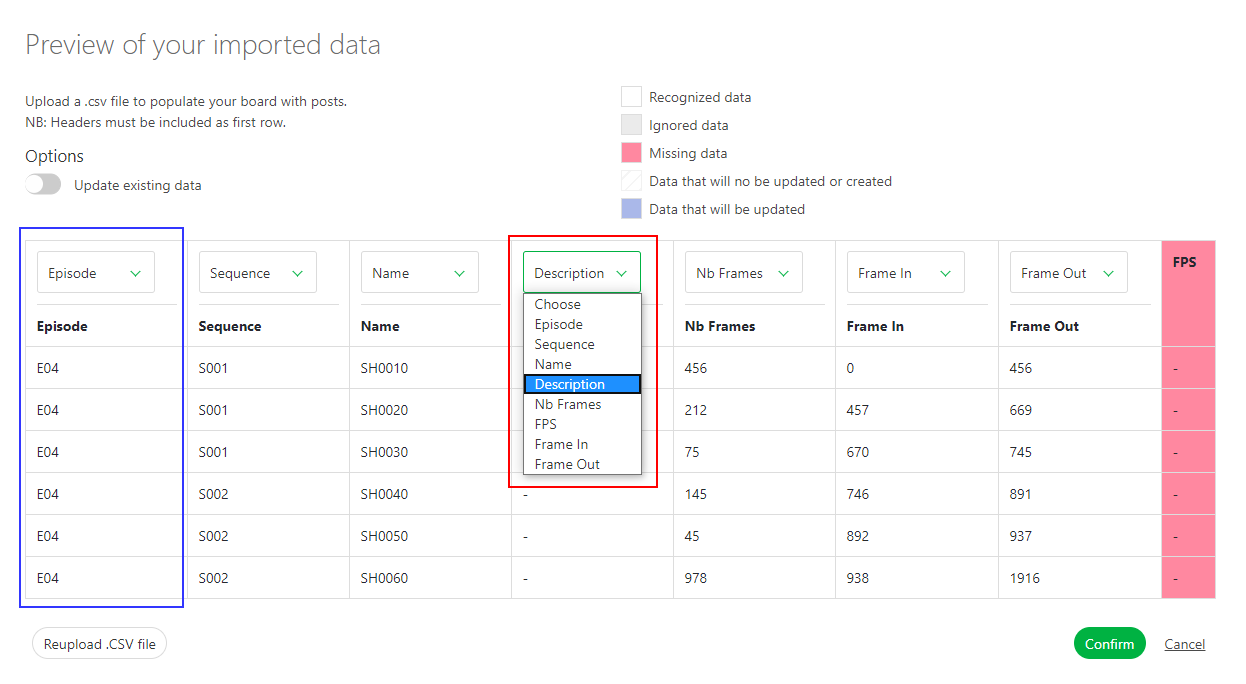
Once everything is good, click the Confirm button to import your data into Kitsu.
Now, all your shots are imported into Kitsu, and the task is created according to your Settings.
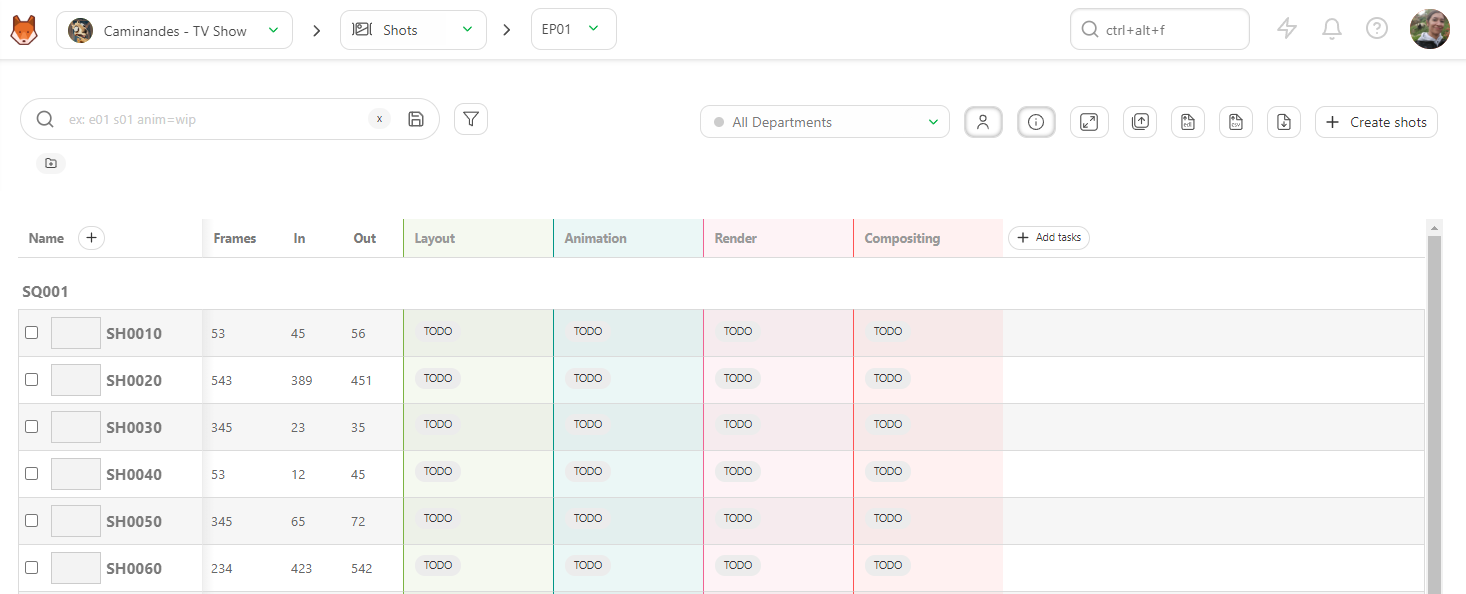
Create Shots by Copying / Pasting a Spreadsheet File
Open your spreadsheet, select your data, and copy them.

Then, go back to the shot page on Kitsu and click on the Import icon
.
A pop-up window Import data from a CSV opens; click on the Paste a CSV data tab.
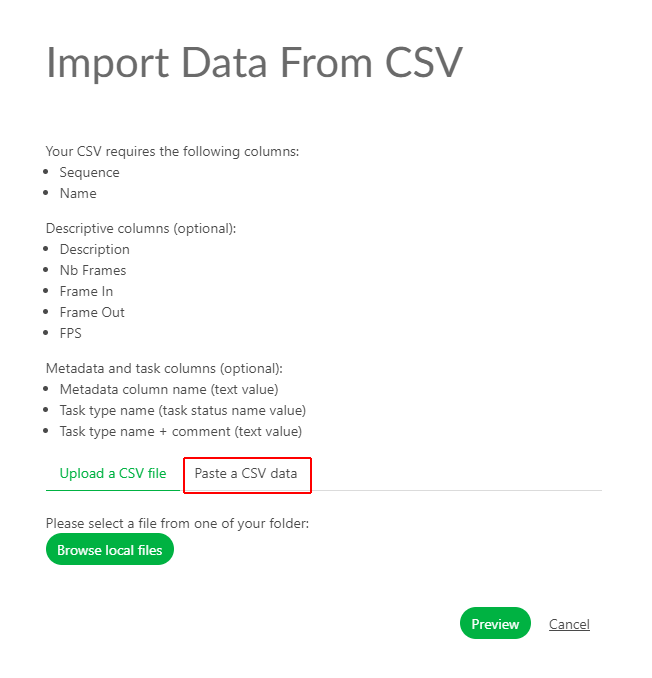 You can paste your previously selected data and see the result with the Preview button.
You can paste your previously selected data and see the result with the Preview button.
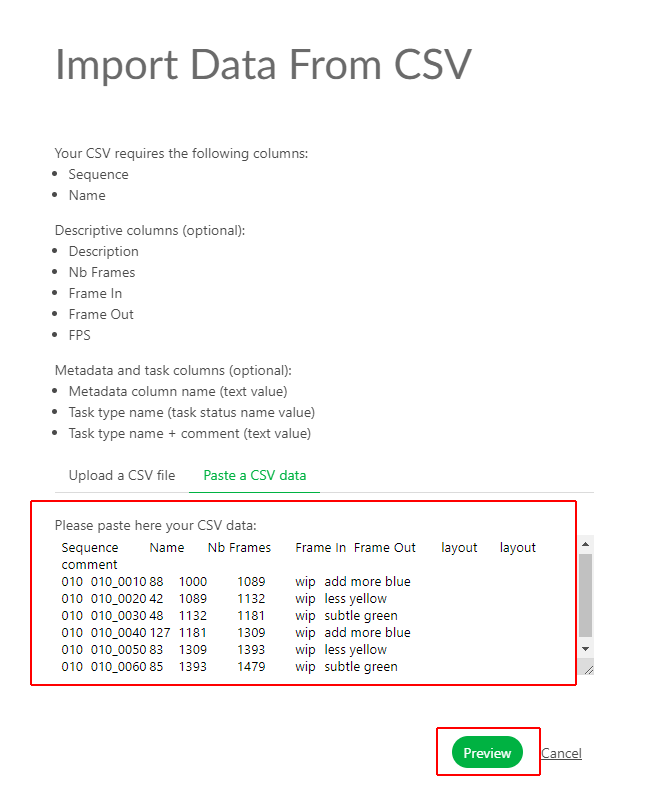 You can check and adjust the name of the columns by previewing your data.
NB: the Episode column is only mandatory for a TV Show production.
You can check and adjust the name of the columns by previewing your data.
NB: the Episode column is only mandatory for a TV Show production.

Once everything is good, click the Confirm button to import your data into Kitsu.
Now, all your shots are imported into Kitsu, and the task is created according to your Settings.

# See the Details of a Shot
If you want to see the details of a shot, click on its name.
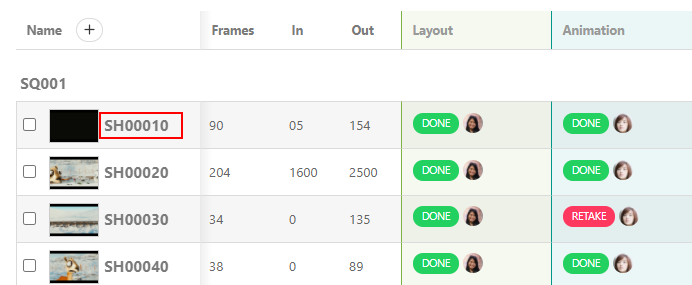
A new page opens with the list of the tasks, the assignation, and the status newsfeed on the right. You can navigate through each by clicking on the name of the tabs.

You can click on the status of each task to open the comment panel and see the history of the comments and the different versions.
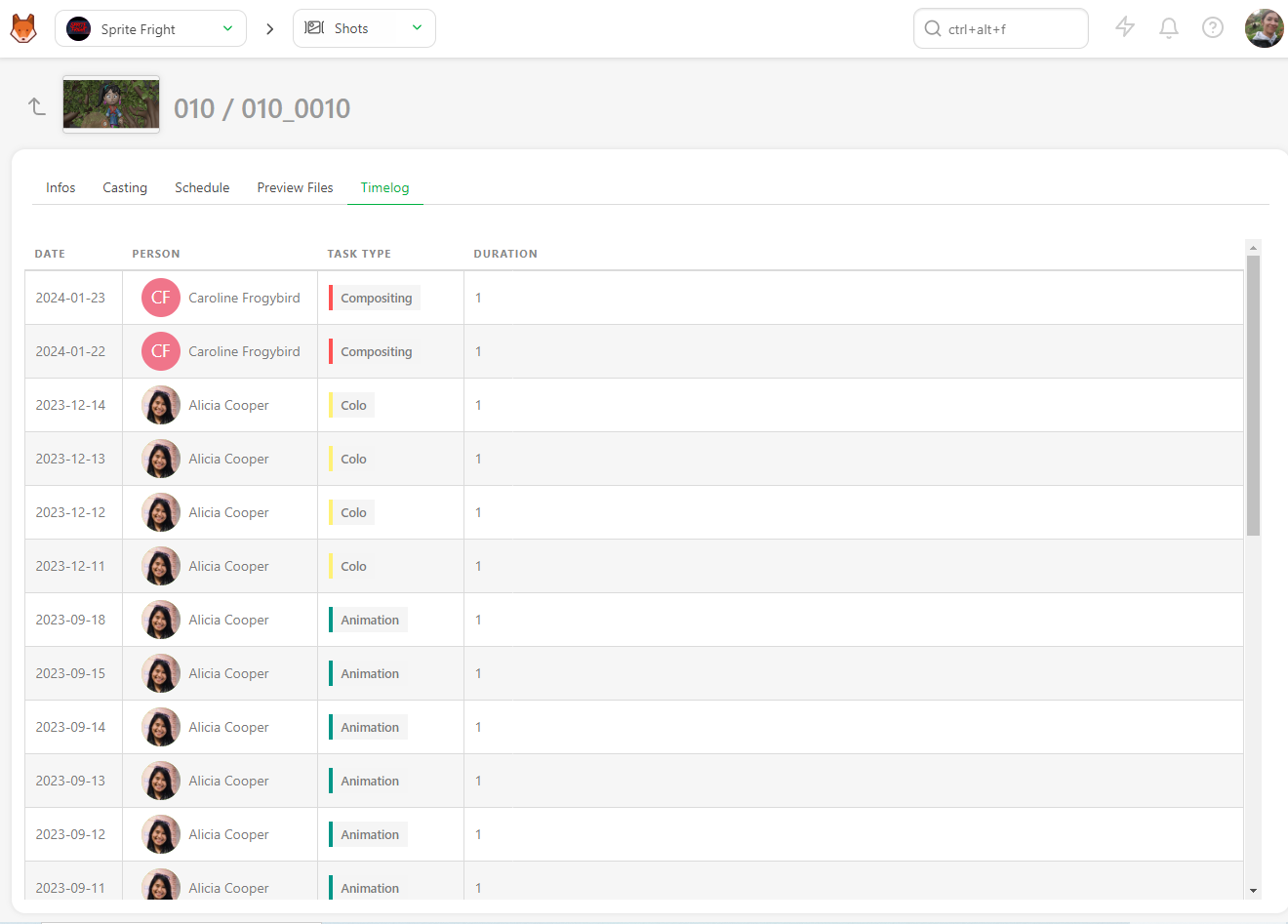
You can also access the Casting,

The Schedule is available if you have previously filled out the task type page data. If the data have already been filled out, you will be able to modify them directly here.
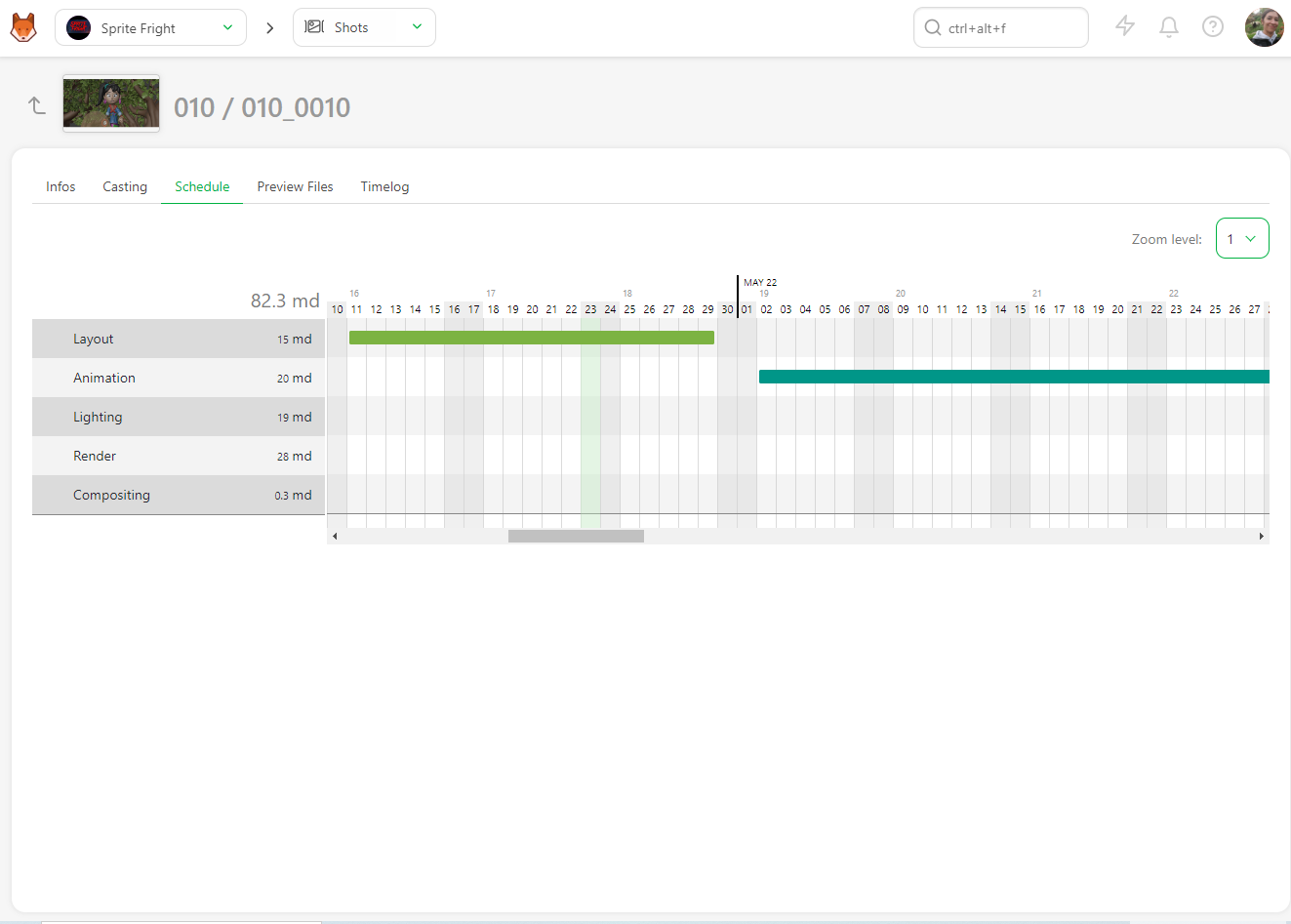
the Preview Files uploaded at various task types,

And the Timelog if people have filled out their timesheet on the tasks of this asset.
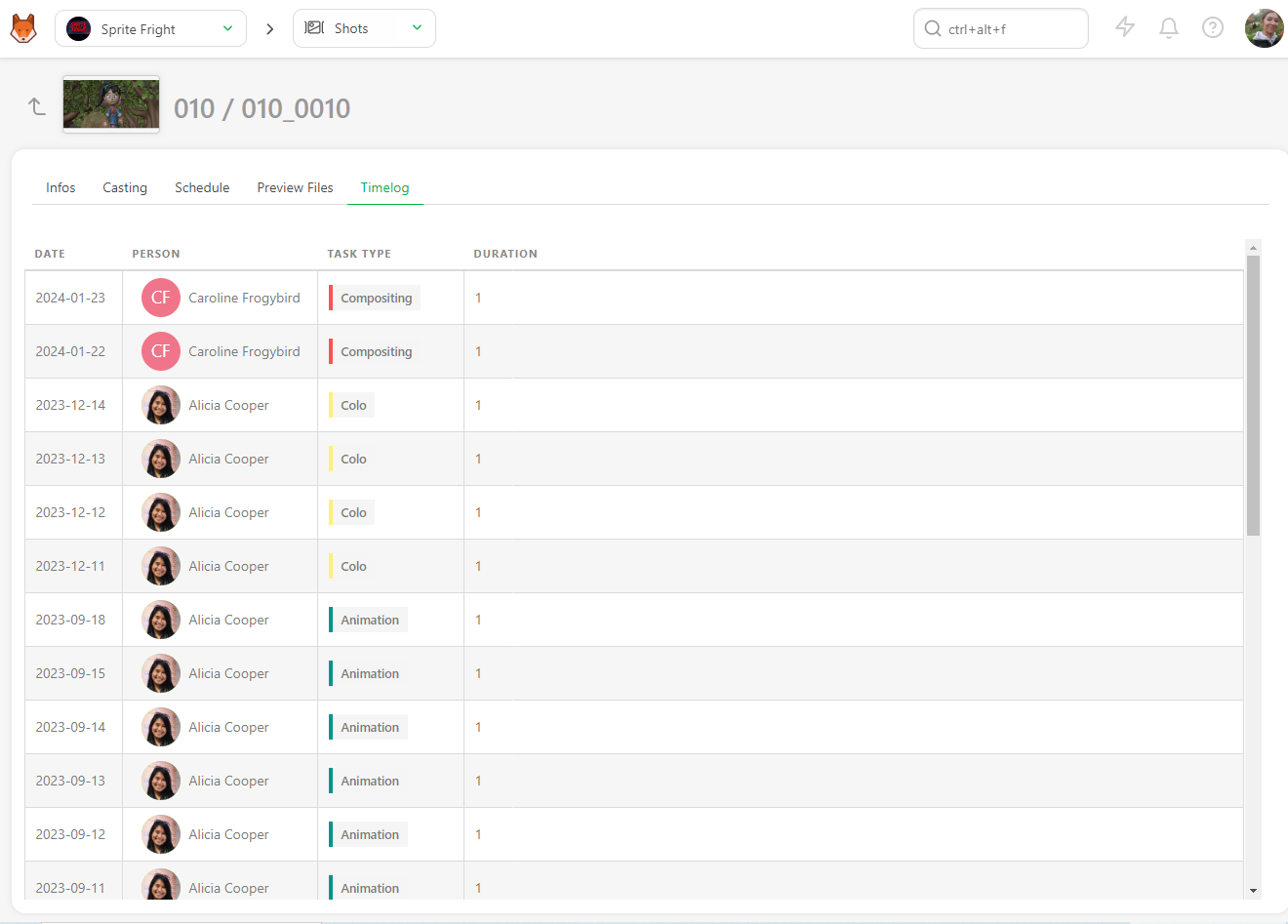
# Add more tasks after creating the shots
If you realize after creating the shots that the task is missing, you can still add them.
First, be sure that the missing task type is added to the settings page under the task type tab.
Then go back to the shot page and click on + Add tasks.
# Update your shots
You can update your shots at any point, change their names and sequences, modify their descriptions, and add any custom information you added to the global page.
You can edit shots by going to the shot page, hovering over the shot you want to modify, and then clicking on the edit button
(1) on the right side of the line.

To extend the description on the main shot page, click on the first words (2), and a pop-up with the full description will open.
Update Shots Information with CSV Import
You can use the CSV Import to update your data as the NB Frames, Frame IN, Frame Out, or any custom Metadata column.
You can update the Assignation , and the Status of tasks and add a Comment.
Open your spreadsheet, select your data, and copy them.

Then, go back to the shot page on Kitsu and click on the Import icon
.
A pop-up window Import data from a CSV opens; click on the Paste a CSV data tab.
 You can paste your previously selected data and see the result with the Preview button.
You can paste your previously selected data and see the result with the Preview button.
 You need to switch on the Option: Update existing data.
The updated shots will be in blue
You need to switch on the Option: Update existing data.
The updated shots will be in blue
NB: the Episode column is only mandatory for a TV Show production.

Once everything is good, click the Confirm button to import your data into Kitsu.
Now, all your shots are imported into Kitsu, and the task is created according to your Settings.

# Add the number of Frames and Frame ranges to the shots
At this stage of the Production, the animatic should be done. This means you have the length (number of frames, Frame range In, and Frame range Out) for each shot. You can add this information to the spreadsheet. This way, you are sure that all the frames are calculated and none are missing or over-computed.
WARNING
If you have created your shots and sequence by hand, the Frame column will be hidden. You must edit at least one shot and fill in the number of frames to display the Frame column. The column will be displayed if you have created your shots and imported the number of frames with a CSV/spreadsheet.
You need to edit the shots to fill in the frame range information. Click on the
edit button on the right
side of the shot line.

On the new window, you can enter the shots In and Out. Then, save by clicking the Confirm button.
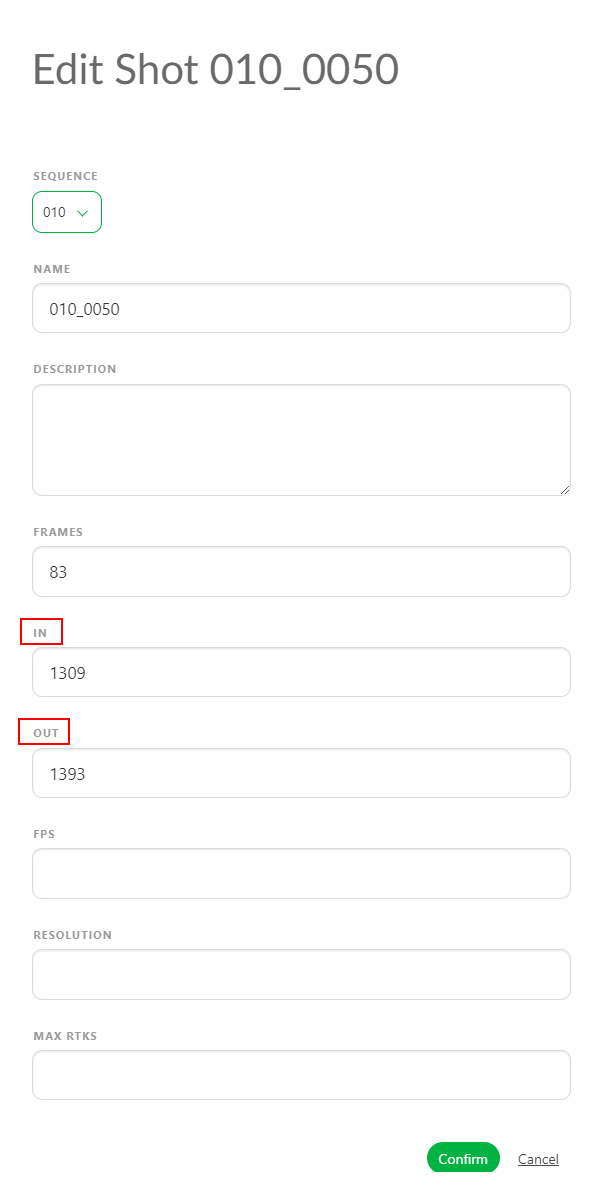
Now, the frame range appears on the general spreadsheet of the shot page.
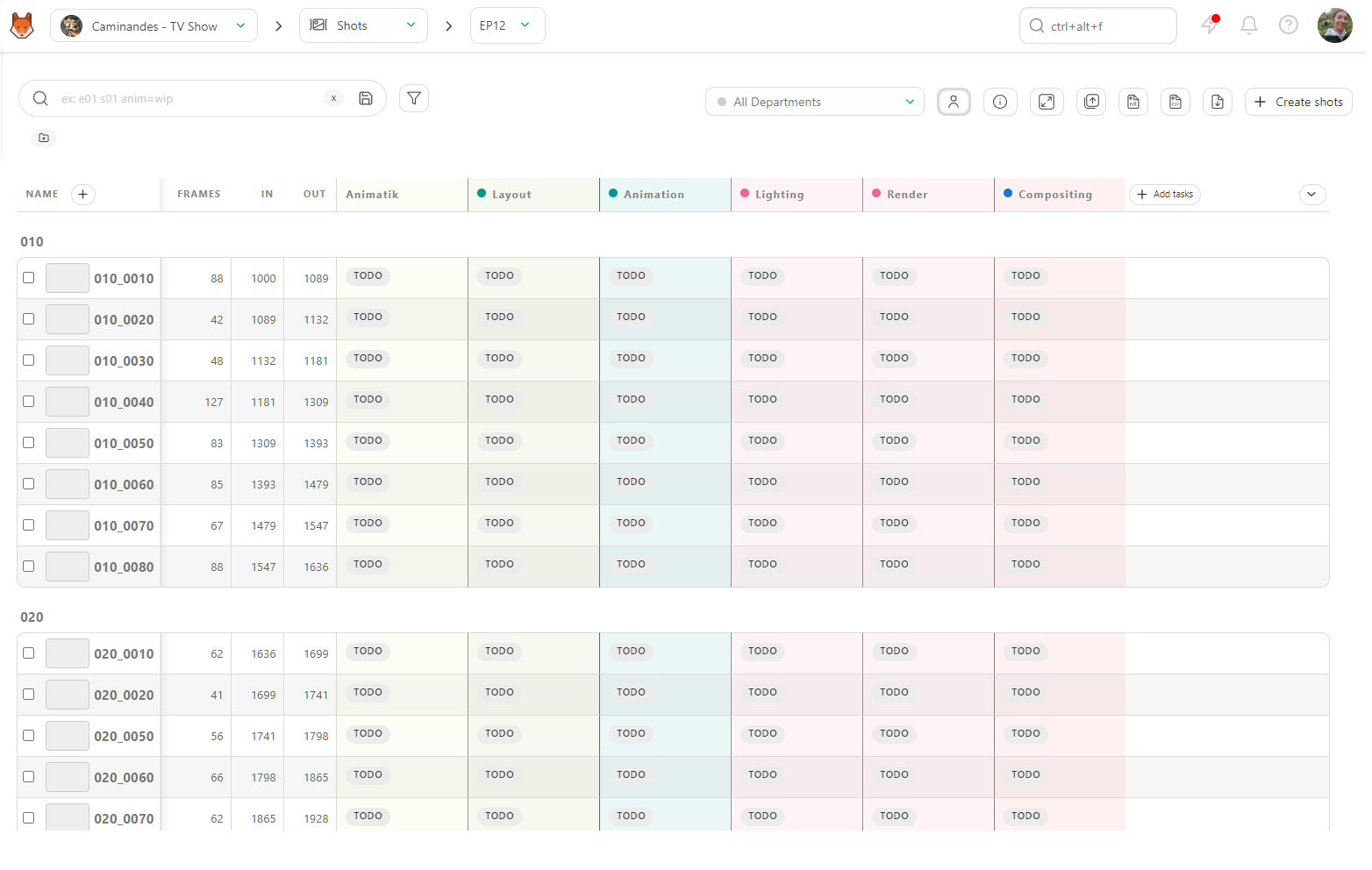
Now that you have unlocked the Frames, In, and Out columns, you can fill them directly from the global shot page.
Click on the case you want to fill in and add the data.
TIP
If you enter the Frame In and Frame Out, Kitsu automatically calculates the Number of Frame.

You can also use the CSV Import to update your frame range quickly. Update Shots information with CSV Import
You can also access the history of shot values.

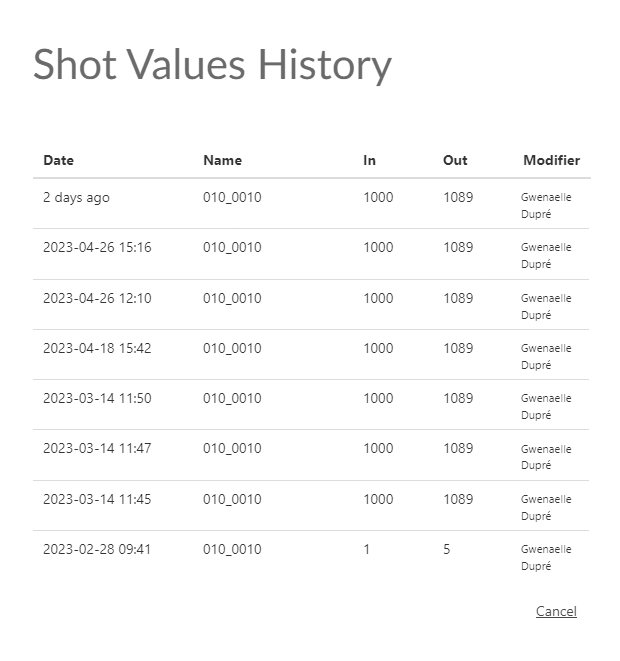
# Create Custom Metadata Columns
To add more information on the general spreadsheet pages, you must create a custom metadata column.
You may have extra information to add to your pages, such as the level of difficulties, Weather, Tag, etc. You can store all text (or number) information in the custom metadata column.
Click on the + near the Name column.
With the Type option, you can choose how you want to store your information:
- a free Text,
- a Number,
- a Checkbox,
- a List of value,
- a List of tags,
- a Checklist.
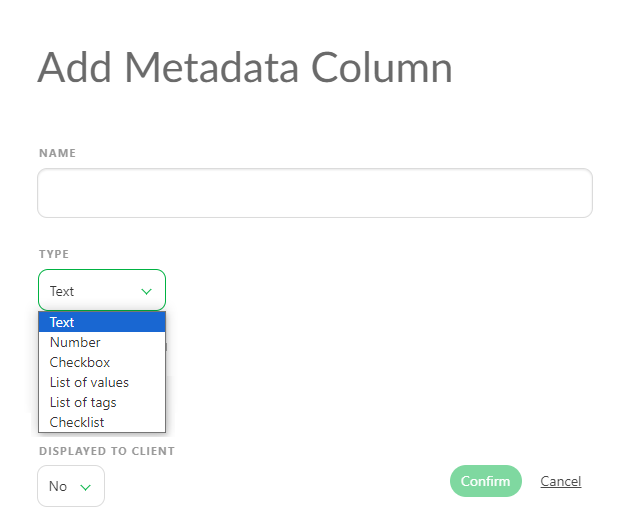
WARNING
The Text, Number, and Checkbox allow you to add different information for each entity. You don't have to plan it first.
The List of value, List of tags, and Checklist give you the same choice for each entity. Moreover, it has to be filled now.
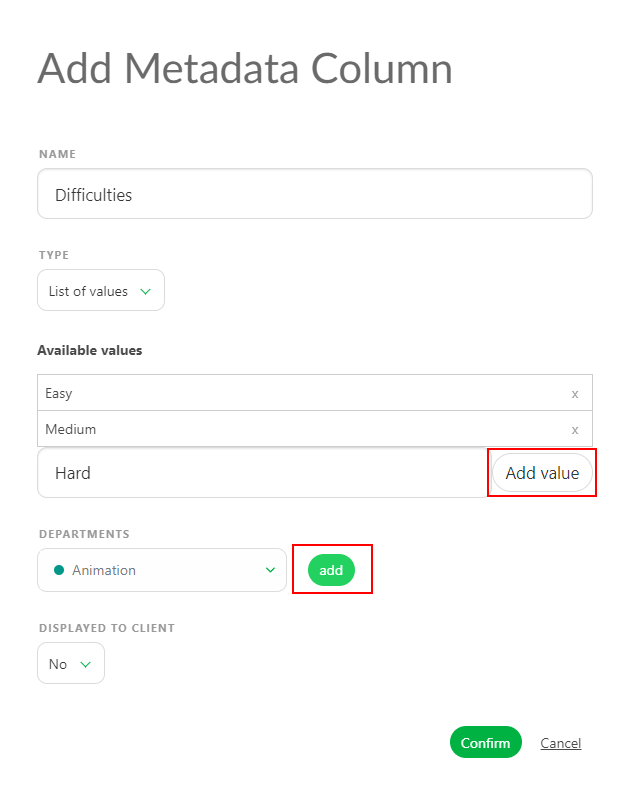
Type the list elements below Available values, and confirm them by clicking on Add value.
You can also link the metadata column to one or several departments.
TIP
Link a metadata column to a department. The artists/supervisors will see it on their to-do page and in the department-filtered view.
You can link the metadata column to one or more departments. Click on the department from the list and then click on add to be effective.
Here, the VFX column is linked to two departments.
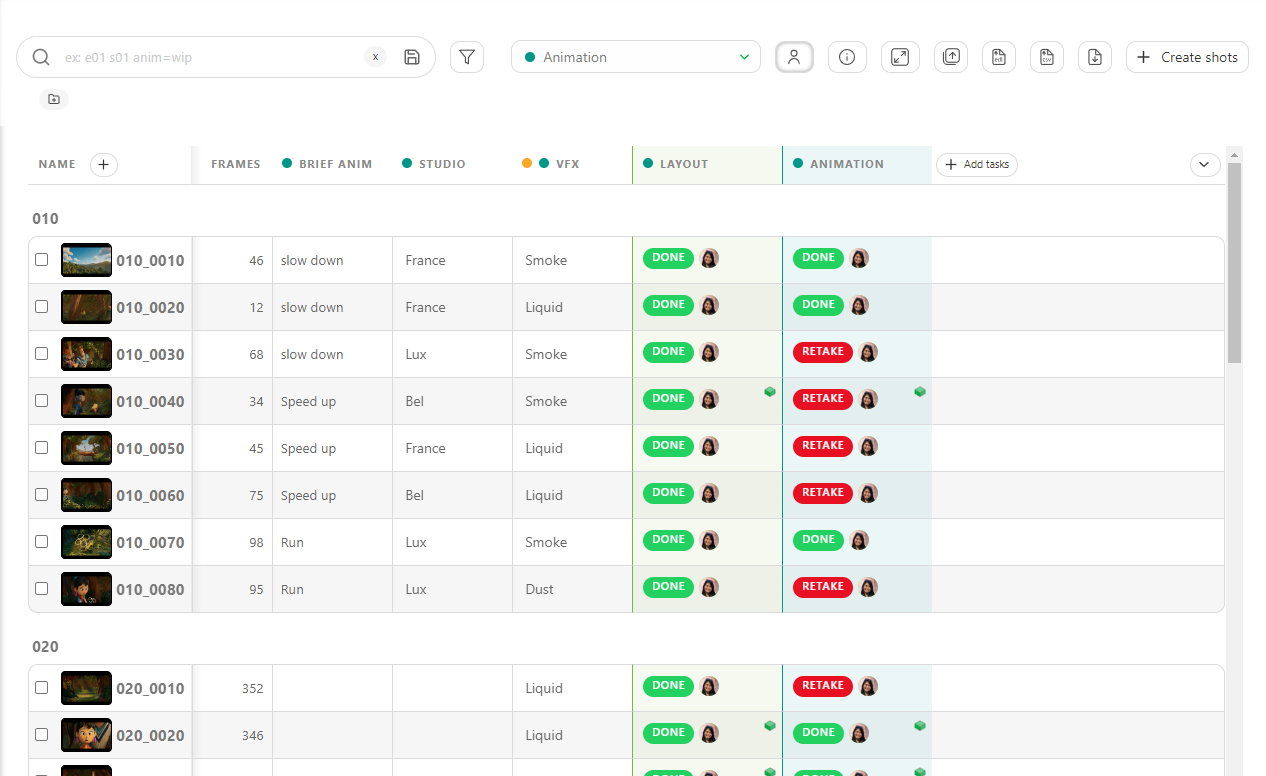
Edit meta column
On the global page of the asset or the shot, click on the arrow on the direct right of your metadata column and click on Edit.
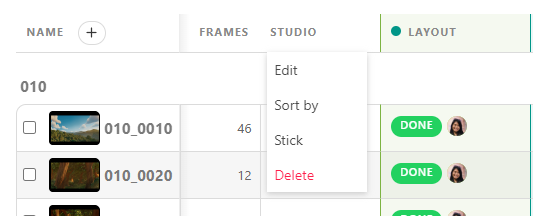
You can fill in this information directly on the global spreadsheets page. The cases are editable.
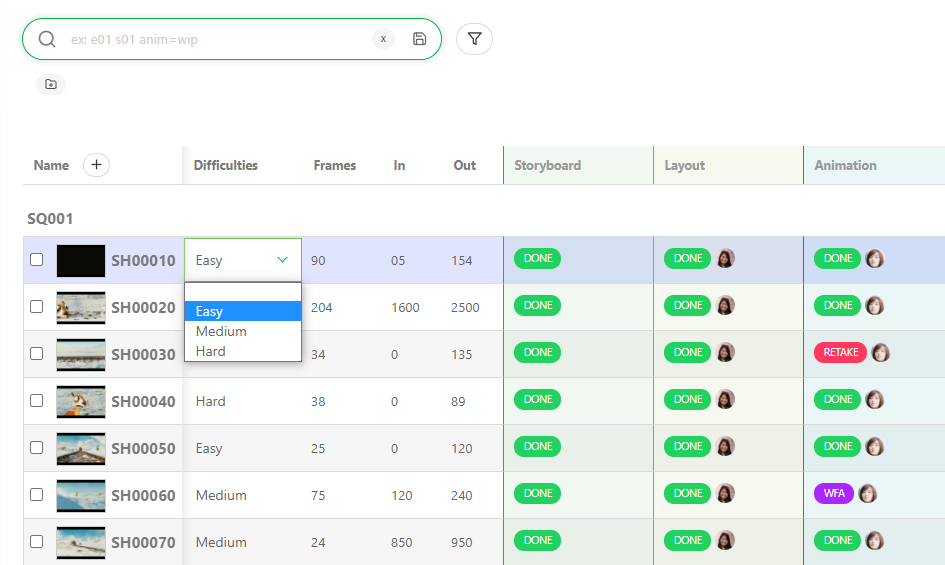
TIP
You can batch-modify the metadata column by selecting several entities on the left and then modifying your metadata column.
Edit by hand
You can also modify the information with the edit button .
You now see a new line on the edit pop-up. You can select the information from the list, alternatively, enter the free text or number, check a box, or use the checklist, depending on your previous choice.
Remember to press the Confirm button when you are done.
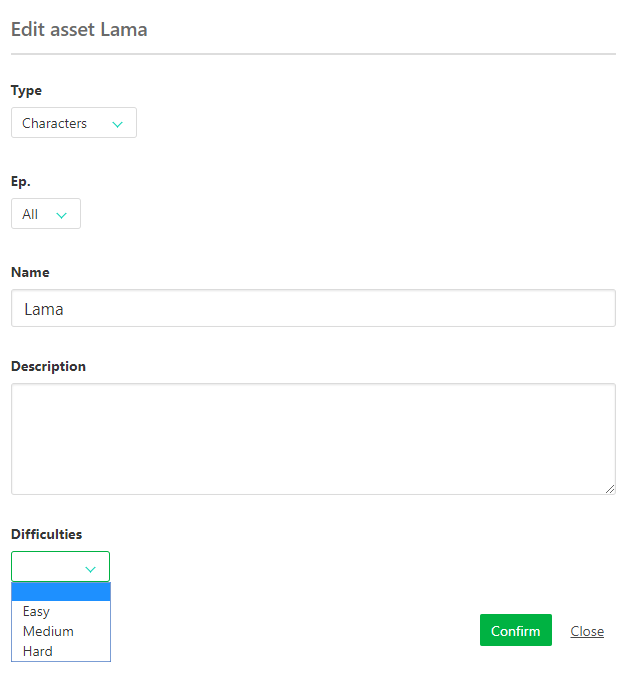
Go to the general spreadsheet page if you need to edit or delete the metadata column.
Nearby the name of your metadata column, click on the arrow .
TIP
You can sort your global page with this new column. Click the arrow on the right of the column name to open his menu. Then click on Sort By.
You can also Stick the metadata column to the left.
# Create a Sequence
In Kitsu, you can also track tasks at the Sequence Level. It's especially useful when you have macro tasks to track, like Story and color Board, Color Grading, etc.
Use the navigation menu to go to the Sequences page.

WARNING
This new page behaves like the asset and shot global page.
To use this page, You first need to create dedicated task types on your Global Library with the Sequence attribute.
See the Creating a New Task Type Section to create a new Task Type.
Once you have created your Task Types on your Global Library, add them to your Production Library (setting page).
Once your task types are ready on the settings page, you need to create a sequence (the same as the assets or shots).
This new page behaves like the asset and shot global page. You can add your edits with the + New Sequence button.
You can assign tasks, do the review, change status, etc.
You can add a metadata column, fill in the description, etc.
TIP
You can create a sequence directly from here (+New sequence button) or create a sequence linked to your shots from the global shot page.
You can Rename and Delete the Sequence entity on this page, as for the asset and shot entity.
If you click on the name of a sequence, you will see the detail page of this sequence.
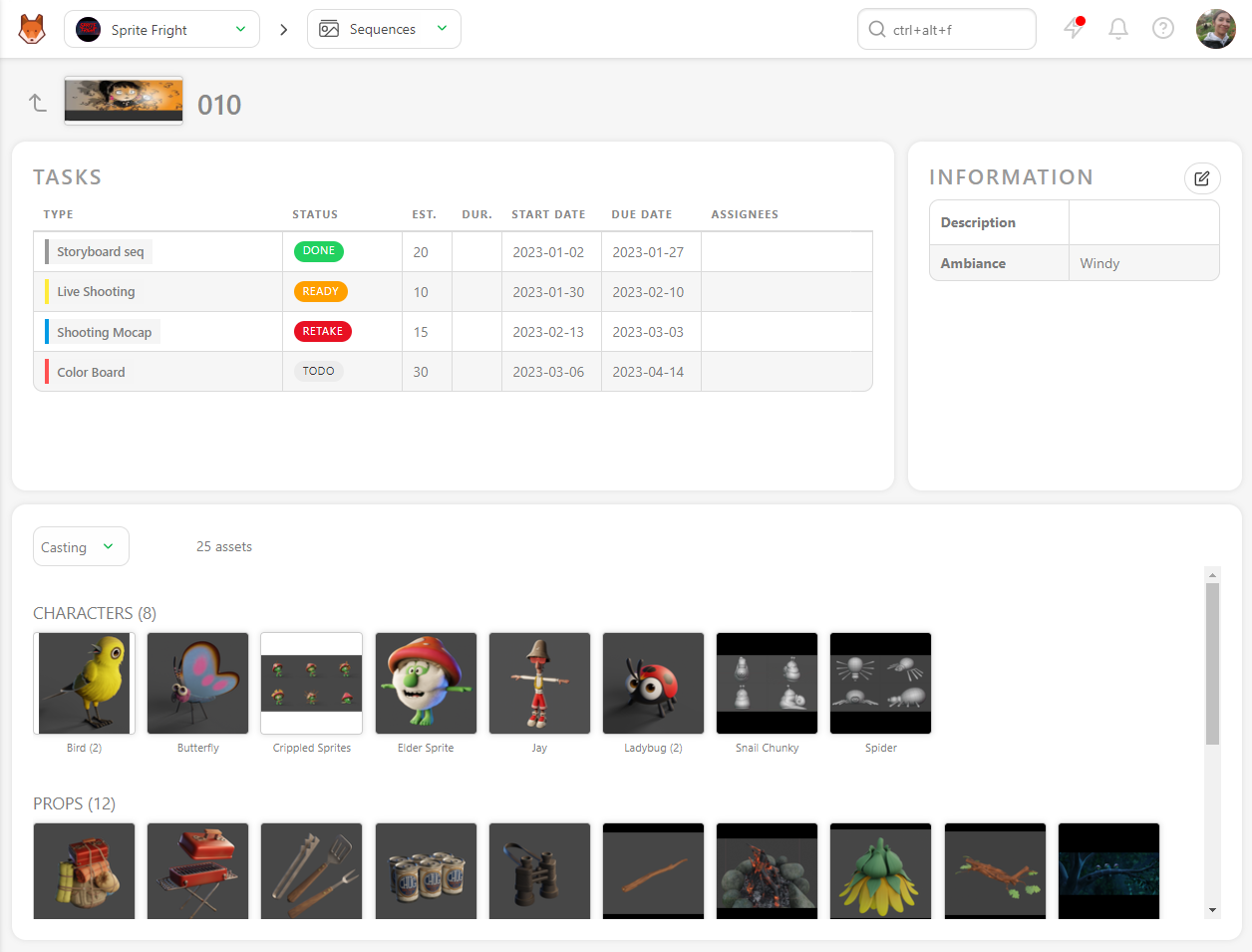
On the detailed page, you have access to the sequence casting. You can see all the assets used in the whole sequence.
You can also access the schedule, Preview Files, Activity, and Timelog of the sequence tasks.
# Create an Edit
You can track tasks at the Edit Level in Kitsu.
It's especially useful when You have several edits to track through several validation steps. For example, you can track your whole movie, several trailers, and the First Edit, Fine Edit, Mix, etc.
WARNING
Per default, the Edit page will not be displayed until you have task types for it on your production library (setting page)
To use this page, you need to first create a dedicated task type on your Global Library with the Edit attribute.
See the Creating a New Task Type Section to create a new Task Type.
Once you have created your Task Types on your Global Library, add them to your Production Library, you will see the Edit displayed on the navigation drop-down menu.

This new page behaves like the asset and shot global page. You can add your edits with the + New edit button.
You can assign tasks, do the review, change status, etc.
You can add a metadata column, fill in the description, etc.
TIP
Depending on your deliveries, you can also change the resolution per Edit.
WARNING
The detail page is different from the other entities.
As Edit focuses on a specific long video, the detail page looks more like the comment detail page.
You can Rename and Delete the Edit entity on this page for the asset and shot entity.